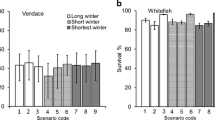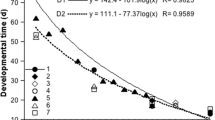Abstract
Many ectothermal marine animals mature at larger sizes in lower temperature environments and at smaller sizes in higher temperature environments. This phenomenon is called the temperature–size rule. To examine whether this rule controls the appearance of large adults in a winter population of caprellids, individuals of Caprella mutica were reared at different temperatures. Caprellids at 5°C died at instar III before they reached maturity. In contrast, the animals reared at 10, 15 and 20°C lived to higher instars and reached maturity within their lifetime. Somatic growth pattern did not change between 10 and 20°C. Maturation instar of males was not affected by temperature. This indicates that the appearance of large adults in winter is not a result of a change in somatic growth pattern with temperature change. However, female maturation size becomes larger due to a delay in maturation at lower temperature. This, in turn, indicates that the temperature–size rule plays a role in the mechanism controlling the appearance of large female adults in winter populations.





Similar content being viewed by others
References
Angilletta MJ, Steury TD, Sears MW (2004) Temperature, growth rate, and body size in ectotherms: fitting pieces of a life-history puzzle. Integr Comp Biol 44:498–509
Aoki M (1996) Precopulatory mate guarding behavior of caprellid amphipods observed in Amakusa, Kyusyu, Japan. Publs Amakusa Mari Biol Lab Kyushu Univ 12:71–78
Atkinson D (1995) Effects of temperature on the size of aquatic ectotherms: exceptions to the general rule. J Therm Biol 20:61–74
Bertalanffy LV (1960) Principles and theory of growth. In: Nowinski WW (ed) Fundamental aspects of normal and malignant growth. Elsevier, New York, pp 137–259
Boos K (2009) Mechanisms of a successful immigration from north-east Asia: population dynamics, life history traits and interspecific interactions in the caprellid amphipod Caprella mutica Schurin, 1935 (Crustacea, Amphipoda) in European coastal waters. Department of Biology, Chemistry and Pharmacy, Freie Universität, Berlin
Bynum KH (1978) Reproductive biology of Caprella penantis Leach, 1814 (Amphipoda: Caprellidae) in North Carolina, USA. Estuar Coast Shelf Sci 7:473–485
Cook EJ, Willis KJ, Lozano-Fernandez M (2007) Survivorship, growth and reproduction of the non-native Caprella mutica Schurin, 1935 (Crustacea: Amphipoda). Hydrobiologia 590:55–64
Fedotov PA (1992) Population and production biology of amphipod Caprella mutica in Posyet Bay, Sea of Japan. Russ J Mar Biol 17:224–230
Gayko LA (2000) Multi-year variations of water and air temperatures in Peter the Great Bay (Sea of Japan). Oceanogr Japan Sea CREAMS’2000, Vladivostok, Russia, pp 193–201
Hirayama A, Kikuchi T (1980) Caprellid fauna associated with subtidal algal beds along the coast of the Oshika peninsula, Tohoku district. Publs Amakusa Mari Biol Lab Kyushu Univ 5:171–188
Hosono T (2009) Effect of temperature on the duration of reproductive cycles of female Caprella mutica (Crustacea: Amphipoda) in the laboratory. Mar Biodivers Rec 2:1–6. doi:10.1017/S1755267209990583
Hosono T, Munehara H (2001) Caprellids (Crustacea, Amphipoda, Caprellidea) from Usujiri, Pacific coast of southern Hokkaido. Bull Fish Sci Hokkaido Univ 52:11–37
Hosono T, Sakurai Y (2006) Life history of Caprella acanthogaster (Amphipoda, Crustacea), a fouling organism on fishery facilities. Aquac Sci 54:107–114
Inglis G, Gust M, Fitridge I, Floerl O, Woods C, Hayden B, Fenwick G (2006) Port of Timaru: baseline survey for nonindigenous species. Biosecurity New Zealand, Wellington
Iribarne O, Fernandez M, Armstrong D (1995) Precopulatory guarding-time of the male amphipod Eogammarus oclairi: effect of population structure. Mar Biol 124:219–223. doi:10.1007/BF00347126
Lee H-W, Ban S, Ikeda T, Matsuishi T (2003) Effect of temperature on development, growth and reproduction in the marine copepod Pseudocalanus newmani at satiating food condition. J Plankton Res 25:261–271
Lewbel GS (1978) Sexual dimorphism and intraspecific aggression, and their relationship to sex ratios in Caprella gorgonia Laubitz & Lewbel (Crustacea: Amphipoda: Caprellidae). J Exp Mar Bio Ecol 33:133–151
Olive PJW (1995) Annual breeding cycles in marine invertebrates and environmental temperature: probing the proximate and ultimate causes of reproductive synchrony. J Therm Biol 20:79–90
Panov VE, McQueen DJ (1998) Effects of temperature on individual growth rate and body size of a freshwater amphipod. Can J Zool 76:1107–1116
R Development Core Team (2009) R: a language and environment for statistical computing. R Foundation for Statistical Computing, Vienna
Reitzel AM, Miner BG, McEdward LR (2004) Relationships between spawning date and larval development time for benthic marine invertebrates: a modeling approach. Mar Ecol Prog Ser 280:13–23
Roff DA (2002) Life history evolution. Sinauer Associates, Inc., Sunderland
Sano M, Omori M, Taniguchi K (2003) Predator-prey systems of drifting seaweed communities off the Tohoku coast, northern Japan, as determined by feeding habit analysis of phytal animals. Fish Sci 69:260–268
Sellheim K, Stachowicz JJ, Coates RC (2010) Effects of a nonnative habitat-forming species on mobile and sessile epifaunal communities. Mar Ecol Prog Ser 398:69–80
Takeuchi I, Hirano R (1991) Growth and reproduction of Caprella danilevskii (Crustacea: Amphipoda) reared in the laboratory. Mar Biol 110:391–397
Takeuchi I, Hirano R (1992) Growth and reproduction of the epifaunal amphipod Caprella okadai Arimoto (Crustacea: Amphipoda: Caprellidea). J Exp Mar Bio Ecol 161:201–212
Takeuchi I, Yamakawa H, Fujiwara M (1990) Density fluctuation of caprellid amphipods (Crustacea) inhabiting the red alga Gelidium amansii (Lamouroux) Lamouroux, with emphasis on Caprella okadai Arimoto. La mer 28:30–36
Vassilenko SV (1986) Rate of oxygen consumption and size-weight characteristics of four species of caprellids. Sov J Mar Biol 12:273–277
Acknowledgments
Sincerest thanks are extended to Yoetu Arashida and Kiyoshi Nomura (Usujiri Fisheries Laboratory of Hokkaido University) for their field assistance and to Chieko Yamada and Youko Uozumi for kindness and help in laboratory works. Thanks are also extended to S. H. Tanaka and K. Steffy (Iwate University) for critically reading earlier versions of manuscripts. I thank anonymous reviewers for their patient review and helpful comments to improve this manuscript.
Author information
Authors and Affiliations
Corresponding author
Additional information
Communicated by S. A. Poulet.
Rights and permissions
About this article
Cite this article
Hosono, T. Effect of temperature on growth and maturation pattern of Caprella mutica (Crustacea, Amphipoda): does the temperature–size rule function in caprellids?. Mar Biol 158, 363–370 (2011). https://doi.org/10.1007/s00227-010-1564-8
Received:
Accepted:
Published:
Issue Date:
DOI: https://doi.org/10.1007/s00227-010-1564-8




